 W
WPrinia is a genus of small insectivorous birds belonging to the passerine bird family Cisticolidae. They were at one time classed in the Old World warbler family, Sylviidae.
 W
WThe ashy prinia or ashy wren-warbler is a small warbler in the family Cisticolidae. This prinia is a resident breeder in the Indian Subcontinent, ranging across most of India, Nepal, Bangladesh, eastern Pakistan, Bhutan, Sri Lanka and western Myanmar. It is a common bird in urban gardens and farmland in many parts of India and its small size, distinctive colours and upright tail make it easy to identify. The northern populations have a rufous rump and back and have a distinct breeding and non-breeding plumage while other populations lack such variation.
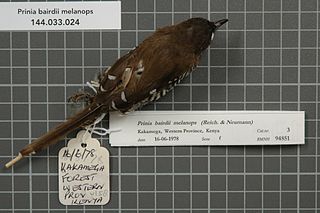 W
WThe banded prinia is a species of bird in the family Cisticolidae.
 W
WThe bar-winged prinia is a species of bird in the cisticola family Cisticolidae. The species is sometimes known as the bar-winged wren-warbler.
 W
WThe black-chested prinia is a species of bird in the family Cisticolidae. It is found in Angola, Botswana, Lesotho, Namibia, South Africa, Zambia, and Zimbabwe. Its natural habitat is dry savanna.
 W
WThe black-throated prinia is a species of bird in the family Cisticolidae. It is found from eastern Nepal, through Bangladesh to Eastern India. It was formerly considered conspecific with the hill prinia.
 W
WThe brown prinia is a species of bird in the family Cisticolidae. The Burmese prinia and the Annam prinia were formerly lumped with this species.
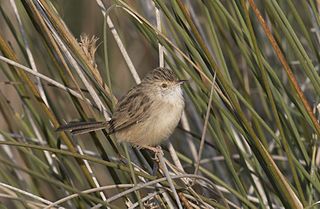 W
WThe delicate prinia is a small warbler. This prinia is a resident breeder in southern Asia, from Turkey to North India.
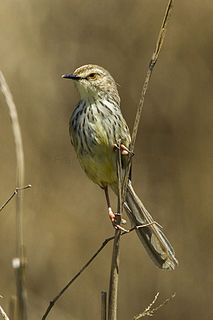 W
WThe Drakensberg prinia or saffron-breasted prinia is a small passerine bird. It lives in eastern South Africa and Swaziland.
 W
WThe graceful prinia is a small warbler. This prinia is a resident breeder in Northeast Africa and southern Asia, from Egypt and Somalia east to Saudi Arabia, where it is sometimes called streaked wren-warbler.
 W
WThe grey-breasted prinia or Franklin's prinia is a wren-warbler belonging to the family of small passerine birds found mainly in warmer southern regions of the Old World. This prinia is a resident breeder in the Indian subcontinent, Sri Lanka and southeast Asia. Like other prinias, it often holds the tail upright but it is easily told by a smoky grey band across the breast which contrasts with a white throat. The beak is all black while the legs are pink. The tail is graduated as in other prinias and the grey feathers are tipped in white. In the breeding plumage the upperparts are grey while non-breeding birds are pale above with rufous wings and a weak supercilium. It is found in scrub, forest clearings and other open but well vegetated habitats. It can be confused with the rufescent prinia.
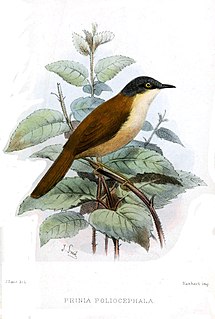 W
WThe grey-crowned prinia is a species of bird in the family Cisticolidae. It is found in Bhutan, northern India and Nepal. Its natural habitats are subtropical or tropical dry forest, subtropical or tropical moist shrubland, subtropical or tropical dry lowland grassland, subtropical or tropical seasonally wet or flooded lowland grassland, and arable land. It is threatened by habitat loss.
 W
WThe hill prinia is a species of passerine bird in the family Cisticolidae.
 W
WThe Himalayan prinia is a species of bird in the family Cisticolidae. It was formerly lumped in with the striped prinia as the striated prinia.
 W
WThe jungle prinia is a small passerine bird, a warbler in the family Cisticolidae.
 W
WThe Karoo prinia or spotted prinia is a small passerine bird. It is a resident breeder in South Africa, Lesotho and far southern Namibia.
 W
WThe pale prinia is a species of bird in the family Cisticolidae. It is found in Ethiopia, Kenya, Somalia, and South Sudan. Its natural habitats are dry savanna and subtropical or tropical dry shrubland.
 W
WThe plain prinia, also known as the plain wren-warbler or white-browed wren-warbler, is a small cisticolid warbler found in southeast Asia. It is a resident breeder from Pakistan and India to south China and southeast Asia. It was formerly included in the tawny-flanked prinia, resident in Africa south of the Sahara. The two are now usually considered to be separate species.
 W
WThe red-fronted prinia, also known as the red-fronted warbler and the red-faced apalis, is a species of bird in the family Cisticolidae. It is found in Chad, Djibouti, Eritrea, Ethiopia, Kenya, Somalia, Sudan, Tanzania, and Uganda. Its natural habitat is dry savanna.
 W
WThe river prinia is a species of bird of the family Cisticolidae. It is found in northwestern Senegal, along the Niger River in the Lake Chad region and nonwestern Kenya. Its natural habitats are subtropical or tropical moist shrubland and swamps.
 W
WRoberts's warbler, also known as the briar warbler, is a species of bird in the family Cisticolidae. It is found in the Eastern Highlands of Zimbabwe and Mozambique. Its natural habitats are subtropical or tropical moist montane forest and subtropical or tropical moist shrubland.
 W
WThe Rufescent prinia is a species of bird in the family Cisticolidae. It is found in Southeast Asia, the Indian subcontinent and southern Yunnan. Its natural habitat is subtropical or tropical dry forest.
 W
WThe rufous-fronted prinia is a species of bird in the family Cisticolidae. It is found in India and Pakistan. Its natural habitat is subtropical or tropical dry forest.
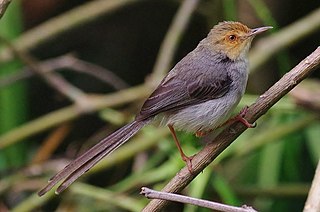 W
WThe São Tomé prinia is a species of bird in the family Cisticolidae. It is endemic to São Tomé and Príncipe and is found in the island of São Tomé. Its natural habitats are subtropical or tropical moist montane forest and subtropical or tropical moist shrubland. The species was named by José Vicente Barbosa du Bocage in 1887.
 W
WThe tawny-flanked prinia is a small passerine bird belonging to the genus Prinia in the family Cisticolidae, a family of Old World warblers. It is widespread and common in most parts of Africa south of the Sahara. The plain prinia of southern Asia was formerly included in this species but is now usually considered to be a separate species.
 W
WThe yellow-bellied prinia is a species of bird in the family Cisticolidae. It is found in Pakistan, the southern Himalayan foothills, the northeastern Indian subcontinent, and Southeast Asia.